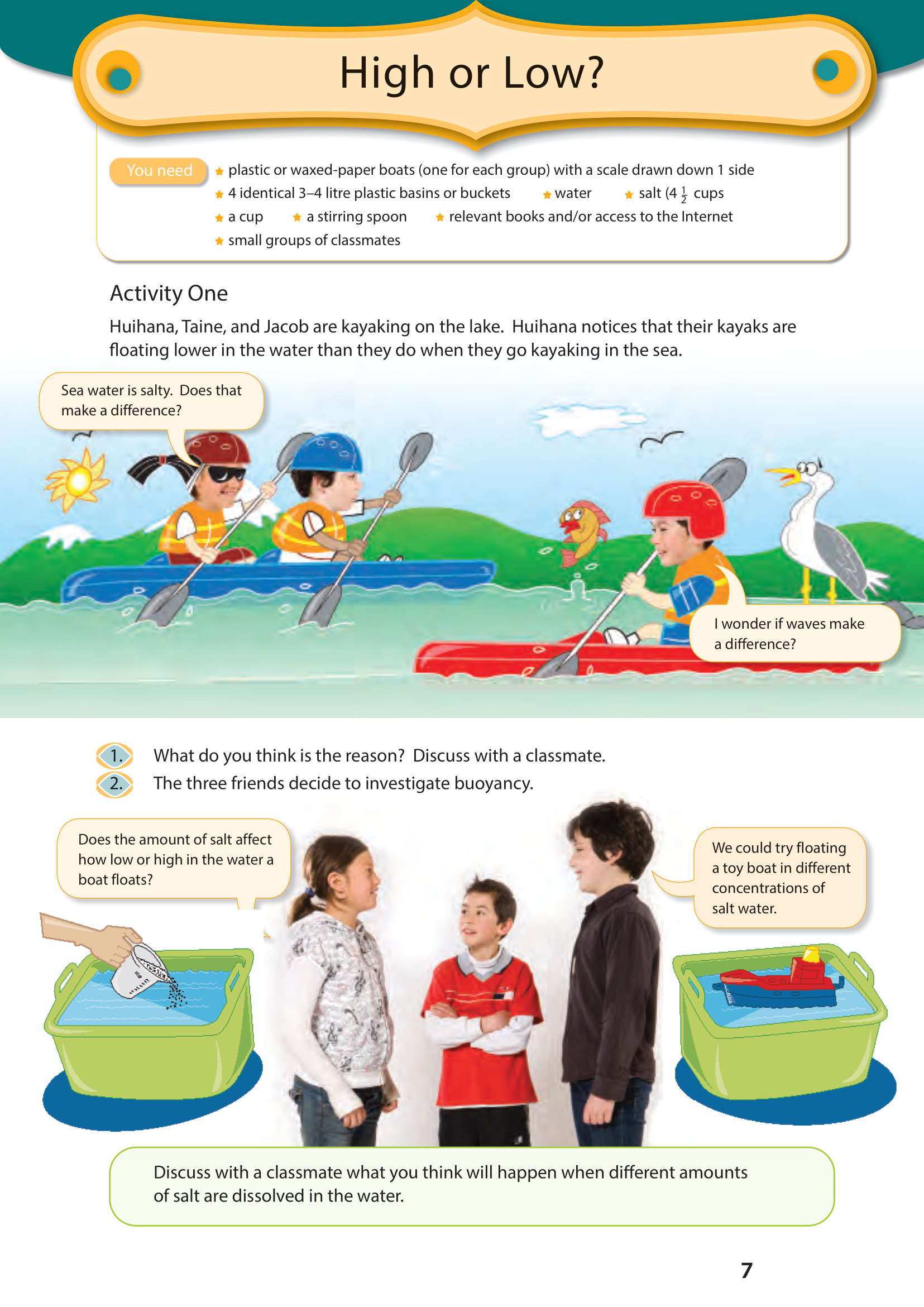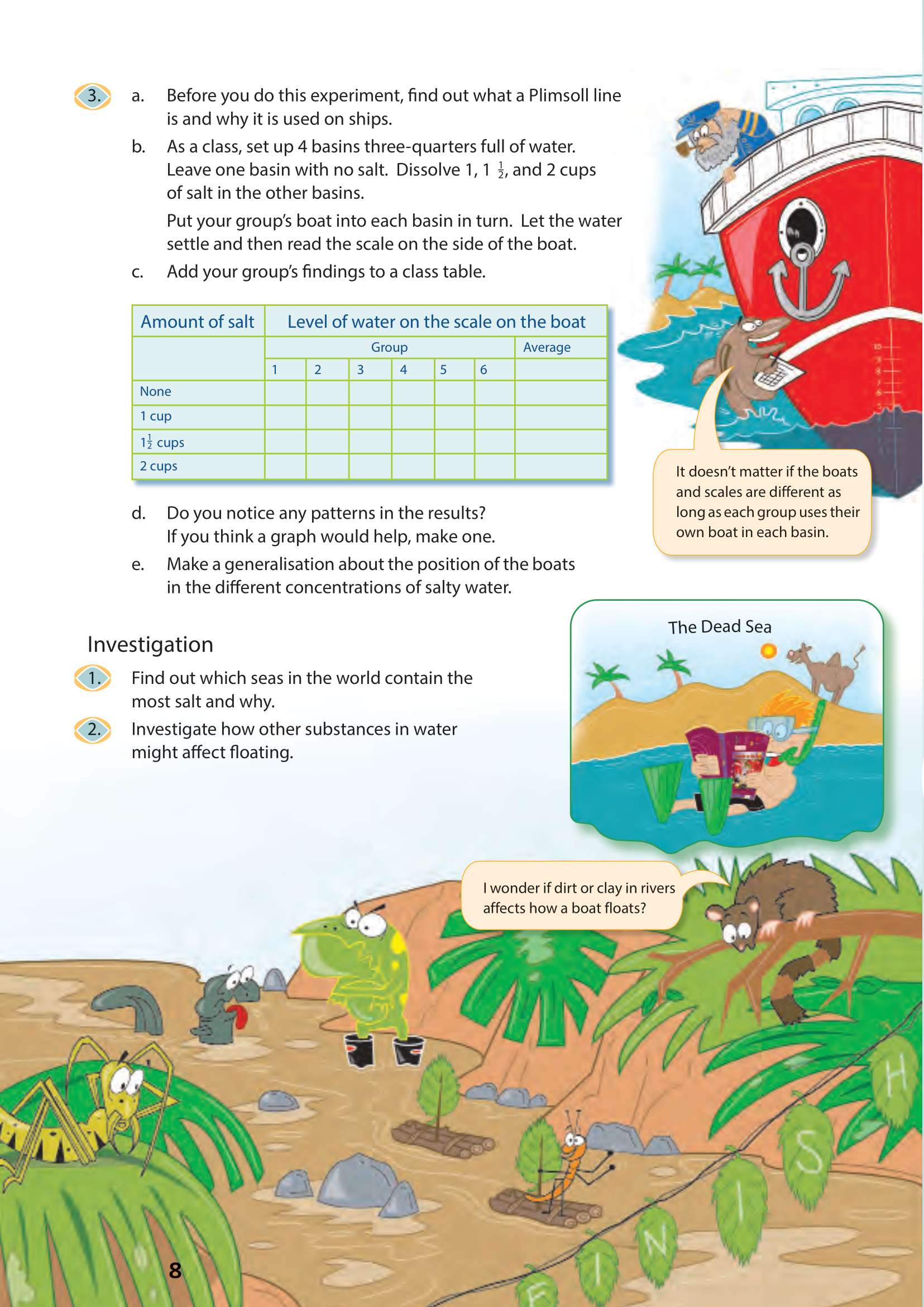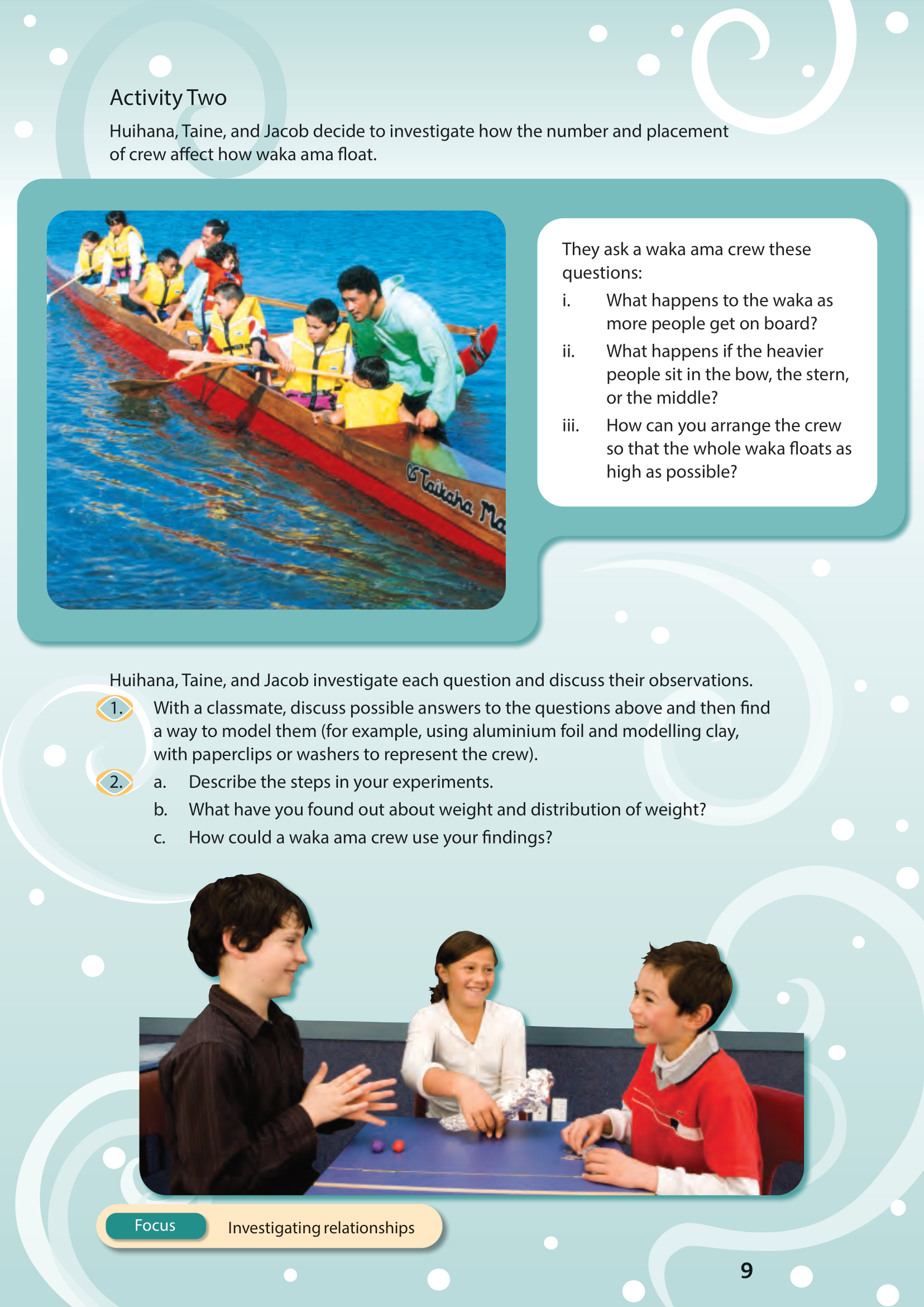This is a level (2+ to 3+) mathematics in science contexts activity from the Figure It Out series.
Click on the image to enlarge it. Click again to close. Download PDF (892 KB)
Students will:
- measure weight, depth, and salt concentration (which is effectively a measure of density)
- find the relationship between the force involved in buoyancy and water density
- find the relationship between the weight of a boat and its floating depth (for a given hull profile)
- record data in tables and use representations to interpret the results.
Students should discover that:
- buoyancy force is a function of the weight of water displaced. Heavier boats need to displace more water to stay afloat (they ride lower). Boats with wide hulls float high in the water because each centimetre of depth displaces a large volume.
salt (4 1/2 cups)
water
a cup
a stirring spoon
relevant books and/or access to the Internet
small group of classmates
4 identical 3-4 litre plastic basins or buckets
plastic or waxed paper boats (one for each group) with a scale drawn down 1 side
FIO, Forces, Levels 2+-3+, High or Low?, pages 7 - 9
Activity One
Preparation and points to note
This activity could get messy, so set appropriate rules and anticipate what might happen if water gets splashed. Make sure the students know how to switch stations at appropriate times. The activity could be done outside or a tarpaulin could be used to protect the floor.
If there are no boats available, groups could use plastic cups or yoghurt pottles for boats and add washers (or modelling clay or marbles) until they sit low in unsalted water. Plastic cups could be marked with their scale on the inside, using waterproof marker pens. The cups or bottles need to have vertical sides and start with enough weights in them so that they float vertically.
Groups may need to use multiple (identical) boats, especially if waxed-paper boats get soaked.
The students will need to use enough water and salt to ensure that there is an appreciable difference in buoyancy between each basin. If all the boats are light and float high in fresh water, sand or weights such as metals washers, coins, or marbles can be added to make them sit lower in the water, making the effect of the changes in density more apparent.
The scale marks on the side of each boat should be at regular intervals.
Points of entry: Mathematics
This activity provides multiple opportunities for talking about measurement and experimental error (for example, the salt may or may not dissolve completely). The students need to create and use their own scales to measure how high their boat sits in the water.
If the irregular shape of the boats makes it difficult to see the trend, repeat the experiment using cylindrical plastic bottles or test tubes, weighted so that they float upright.
The activity also provides an opportunity to focus on the key competency using languages, symbols, and texts because it encourages students to build new knowledge, find ways to describe their thinking, and use tables and graphs to display their findings.
Points of entry: Science
The students will have many ideas about why things float. Use questioning and example–counter-example inductive strategies to refine their ideas. For example, if students think kayaks sit lower in fresh water than sea water because the surrounding body of water is smaller, ask What would happen in a small creek compared with a large river?
Huihana, Taine, and Jacob use the scientific inquiry method (see page 5) to investigate. Point out features of the method, including making a fair trial and having controlled variables.
Have the students compare their results with other groups and make conjectures about why results differ.
Unpack the idea of density. Density is the mass per unit of volume. If the density of the boat is less than that of the water it displaces, it floats. If the density is greater, it sinks. You can increase the density by increasing mass or lowering volume.
An object fl oats in water when the upthrust (the weight of the displaced water) balances the object’s weight. (Note that, in this case, we talk in terms of weight and not mass because buoyancy is a force and weight is a measure of the force of gravity acting on a mass. For an explanation of mass and weight, see the answers and support material for page 1, Introducing Forces.) Adding more salt to the water increases the mass and hence the density of the water (the volume hasn’t changed), which means that the upthrust is greater for the same amount of displaced water.
One way to engage students in thinking about mass and volume with respect to density is to use boats made from paper or aluminium foil. A boat shaped out of waxed paper or foil will float. If you crumple it up so that it has a very small volume, it will not float nearly as well.
Extensions include investigating, in general, why things float. For example, Steel boats are very heavy. Why do they float? (A steel boat occupies more volume than a solid chunk of steel of the same weight. The force of the water pushing the boat up is greater than the weight of the boat [the force of gravity pulling it down]. The larger the volume, the more the upthrust.)
Points of entry: General
See the answers for comment on very salty seas. Students could try out their ideas about substances such as dirt and clay by adding measured amounts to water and stirring until dissolved.
Investigations should be structured so that students can draw meaningful results. Prompt the students to apply the results of their investigation. (This can be linked to thinking in flexible ways, an aspect of the key competency thinking.)
The students’ discoveries do not have to be expressed in numbers in order to activate mathematics and science concepts. For example, a relationship can be as simple as “The muddier the water, the higher a boat floats.” Transfer these ideas to other contexts: On a humid day, the air is less dense because water vapour is less dense than dry air. Will it be easier or harder for planes to take off? (Harder, as the less dense air provides less lift)
Activity Two
Preparation and points to note
The students could use aluminium foil and iceblock sticks to make waka ama models, which they could float in buckets. They could add modelling clay cubes to represent people of different sizes. Narrow, waka-style boats are less stable than other types of boats and are therefore useful for illustrating the effects of the distribution of weight. Encourage the students to explore positioning in their model boats as well as the effect of adding more “people” and to use sketches or photos when documenting their results. Groups could then share their findings with each other and identify relationships.
Points of entry: Mathematics
The students will need to devise appropriate scales and record data systematically. They need to think about what variables they are investigating, for example, distance from the prow (the front part of the boat). Ask them to explain which of these variables are independent and which are dependent.
Prompt your students to make appropriate representations of their data, whether in diagrams, graphs, tables, or other models.
Points of entry: Science
Challenge the students to justify whether or not their findings are valid for a real waka. How do real scientists work? What are you doing that is similar to how real scientists work?
Reinforce the ideas of the scientific inquiry method (see page 5), scale, experimental error, and accuracy. Ask the students to generalise their results as much as possible.
Answers
Activity One
1. There are several factors that affect buoyancy:
- The forces acting on the object. Gravity is pulling the object down, and water is pushing it up. If the object’s weight is balanced by the upthrust, then the object will float.
- The volume of the object. Density is related to volume. If two objects have the same mass and one takes up more space, it has a lower density because it has a bigger volume for the same mass.
- The density of the object compared with the density of the water. If the object is less dense than the water, it will float; if it is more dense, it will sink. Salt water is more dense than fresh water, so things float better in salt water.
These factors are closely related, and they combine to determine whether the object floats or sinks.
2. Ideas will vary. You may think that the salt in the water “holds” the boat up in some way.
The toy boats will float at different levels depending on their weight, the temperature of the water, and how much salt is in the water.
They will float lower in fresh water than in salt water. Boats also float lower in warm water (which is less dense) than in cold water. Warm water will float on top of cold water if the warm water is gently poured onto the cold water and
they are not mixed together.
Salt water is more dense than fresh water, so it pushes harder against objects floating in it. To float in salty water, objects need to displace less water than they do in fresh water.
This is a difficult concept: a fish can float but will be under the water; an iceberg floats but is partially above and partially below the water surface.
3. a. The Plimsoll line indicates the safe loading level of a boat. The markings on the Plimsoll line indicate the safe levels in various circumstances, such as fresh or sea water.
b.–c. Practical activity
d. Findings will vary, but as more salt is added, each boat should float higher in the water and the depth reading should decrease. The pattern should be the same for different types of boats as long as each boat is tested in all the different concentrations. A graph would help to show the trend.
e. A general statement might be: “The more salt, the higher the boats float.”
Investigation
1. The Dead Sea in Israel is the saltiest body of water in the world. The Aral Sea is also extremely salty. Evaporation causes the salt concentration in a body of water to increase because some of the water goes into the atmosphere as water vapour but the salt remains.
2. Findings will vary. Adding mass to water will increase its density. Eventually, the water becomes saturated and nothing more will dissolve in it. Muddy, dense water is more buoyant than clear, fresh water.
Activity Two
1. Discussion and practical activity
2. a. Steps will vary.
b. Adding weight in the centre of a boat lowers the whole boat. Spreading the same amount of weight evenly along the length of the boat has the same effect. Adding mass to one end of the boat tilts that end into the water and raises the other end.
c. Answers will vary. You may be able to talk over your results with a waka ama team or organisers and make recommendations about the number of crew, their weight, their position in the waka, and the effect on speed of being in salt or fresh water. In general, crew should sit evenly along the length of the boat because concentrating the weight in one section of the boat will make it hard to steer.


